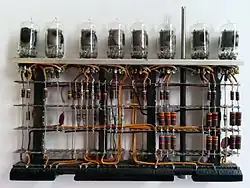5965
| 5965 | |
|---|---|
| Classification | Triode |
| Service | Digital computers |
| Height | 1+15⁄32 in (37 mm) |
| Diameter | 7⁄8 in (22 mm) |
| Cathode | |
| Cathode type | Unipotential |
| Heater voltage | 6.3 V or 12.6 V |
| Heater current | 450 mA or 225 mA |
| Anode | |
| Max voltage | 200 V |
| Max current | 100 mA |
| Socket connections | |
 Pin 1 – Unit 2 Anode (Plate) | |
| References | |
| https://web.archive.org/web/20230314212705/https://frank.pocnet.net/sheets/137/5/5965.pdf | |
The 5965 is a miniature twin triode vacuum tube (thermionic valve) "designed for use in high-speed digital computers".[1]
According to an MIT Project Whirwind memorandum, the tube was developed c.1953 for IBM by GE, primarily for use in the IBM 701 computer, and was designated as a general-purpose triode tube.[2] In European use the tube was labelled E180CC; sometimes the same tube was labelled with both names.[3]

See also
- 7AK7, a popular type of tube found in early digital computers
- 25L6, another type of tube found in early computers
References
- ^ Sylvania. Engineering Data Service. 5965. November 1953.
- ^ Frost, H. B. (May 4, 1953). "Memorandum M-2135: Some notes on current tube types" (PDF). MIT. p. 3. Archived from the original (PDF) on 28 March 2021. Retrieved 12 February 2024.
- ^ Wyatt, Allan (27 December 2012). "5965". The Valve Museum.
It is also labelled as a E180CC showing that the two Types are equivalent.